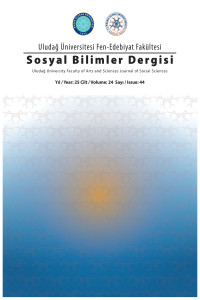Articles
Issue Editorial Board


Aim & Scope
Our
journal accepts the human factor in a direction from the local to the universal
and aims to publish scientific researches in the broadest boundary within its
subjects.
Uludağ
University Faculty of Arts and Sciences Journal of Social Sciences (UUFASJSS)
publishes original research articles in the fields of philology, educational
science, fine arts, and theology etc. with a priority
given to social sciences, humanities, administrative sciences.
Author Guidelines
1. Articles can be written in Turkish or English. The topic must be suited to the content, written with bold and capital letters in 12 font size and be centered. Under the topic, there must be an abstract written in both Turkish and English with 10 font size, italic and single row pitch, consisting of 100-150 words. Five key words must be placed right below the abstract. These key words must be inclusive and coherent with the content. An English title must be with the English abstract. In addition, an extended abstract of the work that is 500-750 words long, written in English and covering the purpose, problem, method, findings and conclusion of the work must be written. This extended abstract must be structured with paragraphs and placed to the page after the source section.
2. The name and the surname of the author should be written as right aligned under the topic of the article. Title, affiliation (University, Faculty, and Department, city and country), e-mail address and ORCID number of the author should be written below the first page with a correlated asterisk near the surname.
3. Except the title of the article, only the first letters of the words should be written with capital letters in in-text topics.
4. At the end of the paper a statement of contribution rate, conflicts of interests, a statement of contribution (if there is one) must be included.
5. Articles must be written by using Microsoft Office Word. Any extra font type must be sent with appendix. The specifications of the page setup must be the following:
6. References to the sources must be given within the text, and footnotes, if necessary, must be put below the page with font size 10. References in the text must include the surname(s) of the author(s), publication date and page number. Page numbers are not necessary for paraphrasing. All the references given in the text must be listed in a separate page at the end of the article under the “Source” topic. They should be listed precisely in alphabetical order. This list cannot include any work that the author does not used in the text.
Source must be prepared according to APA 7 standard.
In-text references should be written between parentheses: (Şahin, 2012: 6).
In papers with two authors, surnames of the two authors must be written with a “&” between: (Yılmaz & Öztürk, 2010: 86)
While referencing works with multiple authors, only the name of the first author should be written: (Gülsevin et al., 2006: 23).
If the author’s name is used within the text, only the publication date and page number should be provided in parenthesis: (2009: 419)
If an author has multiple publications on the same year; a, b, c etc should be used after the publication date: (Çiftçi, 2006a; Çiftçi, 2006b).
References from secondary sources should be cited as well. Köprülü (1926, from Çelik 1998)
7. References
References must be listed at the end of the work, according to alphabetical order of the surnames of their writers. Surnames must be written before the names.
Book
Single Author:
Tanpınar, A. H. (1997). 19’uncu asır Türk edebiyatı tarihi. Çağlayan Kitabevi.
Double Author:
Altun, Ş. & Sarıoğlu, C. (2006). Türk popüler tarihinde ilkler. Alfa Yayınları.
Multiple Author:
İmer, K., Kocaman, A., Özsoy, A. S. (2011). Dilbilim sözlüğü. Boğaziçi Üniversitesi Yayınevi.
Article
Single Author:
Şahin, H. (2016). Bursa’da yazılmış tıp metinlerinde ağız özelliklerine dair. Uludağ Üniversitesi Fen-Edebiyat Fakültesi Sosyal Bilimler Dergisi, 17(31), 291-298.
Double Author:
Şahin, D. & Ünsal, N. D. (2018). Ontario Kraliyet Müzesi’nde sergilenen Edessa kökenli bir grup mozaik pano. Journal of Mosaic Research, (11), 239-256.
Multiple Author:
Alıcı, T., Kayır, H., Aygören, M. O., Sağlam, E, Uzbay, İ. T. (2005). Discriminative stimulus properties of tianeptine. Psychopharmacology, (185), 446-451.
Presentation
Üstünova, K. (2014). Birleşik ekler üzerine. In H. Şahin, İ. Karahancı (Eds.), VI. Uluslararası Dünya Dili Türkçe Sempozyumu Bildirileri II (pp. 889-906), Bursa Büyükşehir Belediyesi Yayınları.
Translated Book
Barthes, R. (2016). Göstergebilimsel serüven. (Trans: M. Rifat, S. Rifat), Yapı Kredi Yayınları.
Book Chapter
Sınar Uğurlu, A. (2020). Mahcupluk İmtihanı adlı oyunda geleneksel Türk tiyatrosunun etkileri. In N. Karaca, M. Başpınar (Eds.), Vefatının 100. Yılında Ömer Seyfettin Kitabı (pp. 49-70), Osmangazi Belediyesi Yayınları.
Encyclopedic Entry
Uzunçarşılı, İ. H. (1997). Mehmed I. in İslâm Ansiklopedisi (pp. 496-506), 7, Millî Eğitim Bakanlığı Yayınları.
Thesis
Aydın, H. (2016). Türkiye Türkçesinde dilbilgisel zaman - Oktay Akbal öyküleri örneği. (Unpublished Doctoral thesis). Bursa: Uludağ Üniversitesi Sosyal Bilimler Enstitüsü.
Manuscript
Âsım. Zeyl-i zübdetü'l-eş‘âr. Millet Kütüphanesi. A. Emirî Efendi. No. 1326. vr. 45a.
Online Source
Kılavuz, A. S. (2020, Aralık 20). Rektör’ün mesajı. http://www.uludag.edu.tr/konu/view/6/RektorMesaji
Geçinme endeksi (ücretliler) elektronik veri dağıtım sistemi. (2009, May 2). http://evds.tcmb.gov.tr/
Paper due to Publication
Ercan, Ö. (2014). Divan şiirini hukukî bakış açısı ile değerlendirmek: suç ve ceza. Uludağ Üniversitesi Fen-Edebiyat Fakültesi Sosyal Bilimler Dergisi. The paper is due to publication.
Ethical Principles and Publication Policy
The following ethical duties and responsibilities are written in the liiiight of the guide and policies made by Committee on Publication Ethics (COPE).
The publication of an article in a peer-reviewed journal is an essential building block in the development of a coherent and respected network of knowledge. It is a direct reflection of the quality of the work of the authors and the institutions that support them. Peer-reviewed articles support and embody the scientific method. It is therefore important to agree upon standards of expected ethical behavior for all parties involved in the act of publishing: the author, the journal editor, the peer reviewer, and the publisher.
1. Publication and authorship:
- List of references, financial support;
- No plagiarism, no fraudulent data;
- Forbidden to publish same research in more than one journal.
2. Author’s responsibilities:
- Authors obliged to participate in peer review process;
- All authors have significantly contributed to the research;
- Statement that all data in article are real and authentic;
- All authors are obliged to provide retractions or corrections of mistakes.
3. Peer review / responsibility for the reviewers:
- Judgments should be objective;
- Reviewers should have no conflict of interest with respect to the research, the authors and/or the research funders;
- Reviewers should point out relevant published work which is not yet cited;
- Reviewed articles should be treated confidentially.
4. Editorial responsibilities:
- Editors have complete responsibility and authority to reject/accept an article;
- Editors should have no conflict of interest with respect to articles they reject/accept;
- Only accept a paper when reasonably certain;
- When errors are found, promote publication of correction or retraction;
- Preserve anonymity of reviewers.
- No plagiarism, no fraudulent data.
5. Publishing ethics issues
- Monitoring/safeguarding publishing ethics by editorial board;
- Guidelines for retracting articles;
- Maintain the integrity of the academic record;
- Preclude business needs from compromising intellectual and ethical standards;
- Always be willing to publish corrections, clarifications, retractions and apologies when needed.
Duties of the Publisher
Uludağ University Faculty of Arts and Sciences Journal of Social Sciences is committed to ensuring that commercial revenue has no impact or influence on editorial decisions. In addition, UUFASJSS will assist in communications with other journals and/or publishers where this is useful to editors. Finally, we are working closely with other publishers and industry associations to set standards for best practices on ethical matters, errors and retractions–and are prepared to provide specialized legal review and counsel if necessary.
Plagiarism Detection
Uludağ University Faculty of Arts and Sciences Journal of Social Sciences uses double-blind review fulfilled by at least two reviewers. In addition, all articles are checked by means of a program (iThenticate) in order to confirm they are not published before and avoid plagiarism.
The peer review process is at the heart of the success of scientific publishing. As part of our commitment to the protection and enhancement of the peer review process, UUFASJSS has an obligation to assist the scientific community in all aspects of publishing ethics, especially in cases of (suspected) duplicate submission or plagiarism.
When a reader discovers a significant error or inaccuracy in a paper published in Uludağ University Faculty of Arts and Sciences Journal of Social Sciences or have any other complaint about editorial content (plagiarism, duplicate papers, etc.), he/she should make a complaint by e-mail to: sbd@uludag.edu.tr We welcome complaints as they provide an opportunity for improvement, and we aim to respond quickly and constructively.
Ethical Committee and Other Permissions
Authors must have permission from the ethical committee and indicate it in their papers in these cases:
- All kinds of research conducted with qualitative or quantitative approaches that require data collection from participants using questionnaires, interviews, focus group work, observation, experimentation, interview techniques,
- The use of humans or other animals (including material and data) for experiments or any other scientific ends,
- Clinical researches on human bodies,
- Researches on animals,
- Retrospective studies that deals about personal data.
In addition:
- The author must have permission from the owner if he uses photographs, polls or scales from another person and indicate it in his paper,
- The author must state that he conforms to the copyright regulations in his use of artistic material.
3. The author has to comply with his research and publication. The articles must not have been published or accepted to be published elsewhere. Proceedings that were presented at scientific meetings but not yet published can be accepted as long as the author states this situation. The legal and ethical responsibilities solely belong to the author. Oral presentations could be published as long as it is stated, they are in full text and they were not published in any other medium.
4. The articles that are written according to the rules must be submitted online via http://dergipark.org.tr/.
Price Policy
No fees are charged from the authors or readers for the articles accepted and published as a result of referee reviews.

This work is licensed under a Creative Commons Attribution 4.0 International License.

